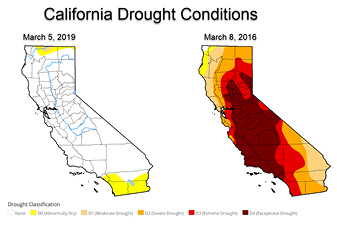|
By Mark Montague, DAT Solutions
We're barely into spring and already it's been an unusual year for weather.
In mid-March, snow in the Rockies closed I-25, I-70, and I-76. Historic rains and saturated land in Nebraska, South Dakota, Iowa, and Wisconsin shut down roadways in the Missouri and Mississippi floodplains. Near Amarillo, Texas, 80-mile-an-hour winds toppled tractor-trailers as they moved down the highway.
In the short term, the weather has disrupted freight movement.
For instance, the challenge of getting freight into Denver last week led to a sharp increase in rates on the van lane from Seattle to Salt Lake City. Then, the surge of West Coast trucks in SLC caused rates on the lane from there to Stockton to decline.
In the coming weeks, expect a boost in flatbed pricing as the demand to move heavy machinery and construction materials into the region picks up.
The weak rate picture is similar in the reefer freight market, where weather conditions have affected the growing season in several markets. The national average spot reefer rate has declined almost every week this year, and the national average in February was 9% lower than it was in February 2018.
But in the long-term, one market is expecting a cumulative benefit to the stormy, snowy weather.
California grows more produce than any other state, and harvests are a huge driver of demand for refrigerated vehicles.
In fact, four of the top five reefer markets last year
|
 California drought conditions in March 2019 versus March 2016. Source: U.S. Drought Monitor/drought.gov
California drought conditions in March 2019 versus March 2016. Source: U.S. Drought Monitor/drought.gov
were in California: Fresno, San Francisco, Los Angeles, and Ontario. Harvests affect capacity in the van and flatbed segments as well, as power units may be diverted to cover higher-paying reefer loads out West.
California experienced three years of drought from 2014 to 2016, which led to loss of crops, reduced yields, shorter growing seasons, and slack demand for trucks. But today the snowpack in the Sierra Nevada mountains is the fifth largest in the past 40 years, and many of the state's reservoirs are at above-average levels.
If growers produce more than they planned for this year, they'll turn to the spot market for capacity.
Until then, reefer rates and volumes continue to feel the chill of a slack freight market. Here's hoping for more predicable weather in the coming months.
Mark Montague is senior industry pricing analyst
for DAT Solutions, which operates the DAT® network of load boards and RateView rate-analysis tool. He has applied his expertise to logistics, rates, and routing for more than 30 years. Mark is based in Portland, Ore.
|


 California drought conditions in March 2019 versus March 2016. Source: U.S. Drought Monitor/drought.gov
California drought conditions in March 2019 versus March 2016. Source: U.S. Drought Monitor/drought.gov